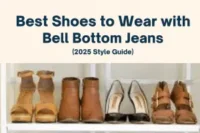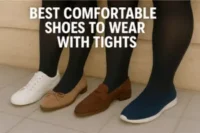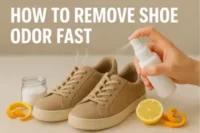15 Smart Ways to Tie Shoelaces for Style & Comfort
Published: 7 Oct 2025
👟 Why Shoelaces Deserve More Attention
Most people tie their shoelaces without thinking; it’s just loop, swoop, pull, and done. But did you know that the way you tie shoelaces can affect how your shoes fit, feel, and even how long they last?
Whether you’re a runner, a sneakerhead, a parent teaching a child, or just tired of your shoes coming undone, learning different ways to tie shoelaces can make a big difference. From secure shoe knots to stylish lacing methods, your options go way beyond the basic bow.
In this guide, you’ll discover smart, easy, and even fashionable shoelace tying techniques, with some focused on speed, others on style, and a few designed to keep your feet pain-free. Ready to lace up smarter? Let’s start with what makes a good knot and why yours might not be doing the job.
🪢 What Makes a Shoelace Knot Good or Bad?
Not all knots are created equal. A good shoelace knot stays tight, keeps your feet supported, and doesn’t come undone during the day. A bad knot? It loosens easily, slips off mid-walk, or leaves one lace longer than the other.
The most common mistake people make is tying a granny knot instead of a proper square knot. They look similar, but the granny knot is weak and fails under pressure. That’s often why your laces come undone while walking.
For a secure shoe knot, the key is balance and tension. Your loops should lie across the shoe horizontally, not at an angle. If they’re angled, you’ve likely tied it wrong.
Before exploring different shoe tying methods, take 10 seconds to check: Are your laces holding up or giving up?
🎯 Quick Overview: 5 Types of Shoelace Goals
Not every knot is meant for the same job. The way you tie your shoelaces should match your purpose, whether it’s comfort, speed, style, or security. Here’s a quick look at the five most common shoelace goals and the tying styles that fit them best:
| Goal | Best For |
| Secure Fit | Runners, hikers, athletes, and daily walkers |
| Speed Tying | Kids, school mornings, busy adults |
| Style Points | Sneakers, streetwear, fashion looks |
| All-Day Comfort | Wide feet, swollen feet, work shoes |
| Slip-On Hack | Casual shoes, errands, no-fuss tying |
Choosing the right shoelace knot isn’t just about looks. It’s about matching your shoes to your lifestyle. From fast shoe tying techniques to stylish lacing methods, we’re about to cover it all, one loop at a time.
🧵 Core Knots: Step-by-Step
Learning different ways to tie your shoelaces can make your life easier and your shoes much more comfortable. Below are five essential shoelace tying methods, each built for a specific need like speed, grip, or simplicity.
- Loop-Swoop-Pull (Standard Knot)
- The classic method most people use
- Great for everyday wear
- Simple to teach and quick to do
- The classic method most people use
- Bunny Ears Method
- Perfect for kids and beginners
- Involves making two loops and tying them together
- Easy to remember and fun to learn
- Perfect for kids and beginners
- Double Knot
- Adds extra hold to the basic bow
- Helps prevent laces from coming undone
- Ideal for school shoes, running shoes, and slippery surfaces
- Adds extra hold to the basic bow
- Ian Knot (Fastest Way to Tie Shoes)
- A super-speed method using both hands at once
- Known as the fastest shoelace knot
- Quick, reliable, and great for busy mornings
- A super-speed method using both hands at once
- Surgeon’s Knot
- Adds a second loop before finishing the bow
- Creates a secure shoe knot that holds tight
- Best for athletes, hikers, or anyone needing extra grip
- Adds a second loop before finishing the bow
These knots are the foundation for everyday function.
🎨 Creative Lacing Styles for Look & Function
Laces aren’t just for tying; they’re part of your style. With the right lacing method, you can turn any shoe into a fashion statement or improve how it fits your foot. Here are some popular and creative ways to lace shoes, from functional to flashy:
- Criss-Cross Lacing
- The classic method, easy and effective
- Offers balanced tension and a clean look
- Great for everyday sneakers and school shoes
- The classic method, easy and effective
- Straight Bar Lacing (Fashion Lace)
- Laces run straight across the eyelets
- Creates a sleek, minimalist look
- Popular on dress shoes and sneakers for a clean style
- Laces run straight across the eyelets
- Heel-Lock Lacing (Runner’s Loop)
- Adds extra hold at the top of the shoe
- Prevents heel slippage during movement
- Perfect for running shoes and hiking boots
- Adds extra hold at the top of the shoe
- Lattice Lacing
- A stylish, criss-cross pattern with diagonal overlaps
- Looks great on high-top sneakers or fashion shoes
- Offers firm support and visual flair
- A stylish, criss-cross pattern with diagonal overlaps
- Loose-Lace Look(for streetwear)
- Laces are styled loosely without tying a bow
- Trendy among sneaker lovers and skaters
- Works best on Vans, Jordans, and Dunks
- Laces are styled loosely without tying a bow
- Checkerboard / Two-Tone Lacing
- Use two lace colors to create bold, checker-style patterns
- Eye-catching and perfect for personalizing your shoes
- A hit with sneakerheads and DIY fashion fans
- Use two lace colors to create bold, checker-style patterns
Creative lacing isn’t just about style; it can change how your shoes feel, fit, and function.
👞 Shoelacing Tips Based on Shoe Types
Not all shoes are made the same, and the same goes for their laces. Using the right shoelace tying method for the right shoe can improve comfort, support, and even style. Here’s how to lace smart for each shoe type:
- Running Shoes
- Use the heel-lock lacing method to stop heel slippage
- Try the surgeon’s knot for a secure grip
- Great for runners and athletes who need stability
- Use the heel-lock lacing method to stop heel slippage
- Fashion Sneakers
- Go for straight bar or loose-lace styles for a clean, casual look
- Use checkerboard lacing to stand out
- Ideal for daily wear, streetwear, and sneaker culture
- Go for straight bar or loose-lace styles for a clean, casual look
- Dress Shoes
- Use straight-lace (fashion lace) for a neat, formal appearance
- Avoid bulky knots; keep it flat and minimal.
- Perfect for suits, office wear, and events
- Use straight-lace (fashion lace) for a neat, formal appearance
- Hiking Boots or Work Boots
- Use the surgeon’s knot or ladder lacing for firm ankle support
- Always finish with a double knot to prevent loosening
- Key for long walks, outdoor jobs, and rough terrain
- Use the surgeon’s knot or ladder lacing for firm ankle support
- Kids’ Shoes
- Stick with the bunny ears method or loop-swoop-pull
- Use colorful or elastic laces for fun and ease
- Helps kids learn quickly and stay comfortable
- Stick with the bunny ears method or loop-swoop-pull
Matching your lacing method to your shoe type makes a real difference.
🧠 Shoelace Hacks & Tricks You’ll Actually Use
Shoelaces can be annoying: too short, too long, or always coming undone. These quick, smart shoelace hacks solve those problems fast and make your shoes way more comfortable.
- Short Lace Fix
- Start lacing closer to the toe box
- Skip one or two eyelets to save lace length
- Works great for shoes with 5 or more lace holes
- Start lacing closer to the toe box
- Uneven Laces?
- Use the “pinch and pull” method before tying
- Even out both sides before you loop
- Prevents one lace from ending up way shorter
- Use the “pinch and pull” method before tying
- Slippery Laces?
- Try a double knot or a surgeon’s knot
- Or switch to textured or waxed laces for better grip
- Great for runners and anyone using round or glossy laces
- Try a double knot or a surgeon’s knot
- Turn Shoes into Slip-Ons
- Use elastic no-tie laces or tuck the laces inside the shoe
- Perfect for kids, casual wear, or people on the go
- Use elastic no-tie laces or tuck the laces inside the shoe
- Tying Without a Bow
- Loop your laces under the tongue or around the top eyelets
- Gives a clean, bow-free look that’s popular in streetwear.
- Loop your laces under the tongue or around the top eyelets
These little tweaks go a long way.
⚠️ Common Shoelace Mistakes (And How to Avoid Them)
Even the most stylish lacing or the strongest knot can fall apart if you’re making small mistakes. Here are some common shoelace slip-ups people make — and how to fix them fast:
| Mistakes to Avoid |
|---|
|
Avoiding these little mistakes makes every tying method more effective.
🧼 Shoelace Care 101: Keep Them Clean, Strong & Stylish
Your shoes might be clean, but what about your laces? Dirty, frayed shoelaces can ruin the look of even the best sneakers, and weak laces don’t hold knots well. Here’s how to keep your shoelaces in top shape:
- Wash Regularly
- Remove laces and soak them in warm, soapy water
- Use a toothbrush to scrub dirt from textured laces
- Air dry and never use a dryer.
- Remove laces and soak them in warm, soapy water
- Replace When Worn
- If your laces are fraying or losing grip, swap them out
- Choose the right length and thickness for your shoe type
- If your laces are fraying or losing grip, swap them out
- Choose the Right Lace Material
- Flat laces stay tied better and are easier to manage
- Round laces look sleek but can be slippery
- Elastic laces are perfect for slip-on shoes and kids
- Flat laces stay tied better and are easier to manage
- Store Extras Smartly
- Keep spare laces in a drawer or travel kit
- Match by color and length to make switching easy
- Keep spare laces in a drawer or travel kit
Good shoelace care helps your knots stay tight, your shoes look better, and your daily routine run smoother.
🚀 Ready to Step Up? Tie Smarter, Walk Better
Who knew something as simple as tying your shoelaces could make such a big difference? Whether you’re chasing comfort, speed, style, or security, choosing the right shoelace knot or lacing method can completely change how your shoes fit and feel.
From the classic loop-swoop-pull to the lightning-fast Ian Knot, and from heel-locks for runners to fashion lacing for sneakerheads, you’ve now got the tools to tie with purpose.
Try a new method. Teach it to a friend. Help your kid finally master those “bunny ears.” Or just stop your laces from coming undone every hour.
Laces may be small, but they hold everything together.
👟 Ready to lace up your shoes in a better way? Pick your method and step out in style.
❓ Frequently Asked Questions About Shoelaces
Many laces slip because of the granny knot—it looks like a normal bow, but is weaker. True shoelace bows are usually based on a square (reef) knot, which gives better balance.
Walking puts dynamic stress on the laces as they stretch and relax with each step, while loose ends are pulled by swinging legs.
To fix it, try these:
- Use a double knot or surgeon’s knot for extra grip
- Use textured or waxed laces
- Make sure your loops lie flat (horizontal) across the shoe
The Ian Knot is often called the fastest way to tie shoelaces. You form both loops and pull them through simultaneously, completing the bow in one fluid motion.
It takes practice at first, but once you master it, it’s faster than the traditional loop‑swoop method.
For even more security, try Ian’s Secure Knot / Double Slip Knot, which adds one extra wrap but remains relatively quick.
Here are helpful tips:
- Use the bunny ears method — two loops, cross them, pull through. It’s simple to teach and easy to grasp.
- Use two different-colored laces so they can follow the color instructions.
- Practice with the shoe on a table first (not on the foot).
- Use “backward chaining”. You do most steps first, let the child do the last step, then gradually add more.
- Be patient and repeat. Every child learns at their own pace.
Yes — the material and shape of shoelaces matter.
- Flat laces tend to grip better and keep knots more stable.
- Round or glossy laces can be slipperier and cause knots to loosen.
- Waxed or textured laces add friction, helping knots stay put.
- Also, replace laces when they’re frayed or stiff — worn laces lose grip.
Yes — some creative methods avoid the visible bow:
- Use elastic “no‑tie” laces. They let you slip the shoe on and off without tying.
- Tuck the laces under the tongue or inside the shoe body for a clean look.
- Use methods like loop-back tying or hidden knot techniques where the bow is concealed inside.
- This is useful for minimalist style, dress shoes, or for people wanting a bow‑free finish.

- Be Respectful
- Stay Relevant
- Stay Positive
- True Feedback
- Encourage Discussion
- Avoid Spamming
- No Fake News
- Don't Copy-Paste
- No Personal Attacks



- Be Respectful
- Stay Relevant
- Stay Positive
- True Feedback
- Encourage Discussion
- Avoid Spamming
- No Fake News
- Don't Copy-Paste
- No Personal Attacks





